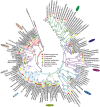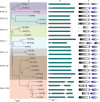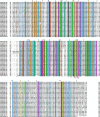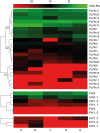Genome-Wide Analysis and Evolution of the Pto-Like Protein Kinase (PLPK) Gene Family in Pepper
- PMID: 27536870
- PMCID: PMC4990186
- DOI: 10.1371/journal.pone.0161545
Genome-Wide Analysis and Evolution of the Pto-Like Protein Kinase (PLPK) Gene Family in Pepper
Abstract
The tomato Pto gene, which encodes a serine/threonine kinase (STK) domain-containing protein, confers resistance to bacterial speck disease caused by Pseudomonas syringae pv. tomato (Pst). In this study, in vivo recognition assays using PVX constructs showed that AvrPto was specifically recognized in the pepper genotypes. This AvrPto recognition caused a nonhost hypersensitive response (HR) and localization of the PVX::AvrPto fusion protein to inoculated pepper leaf tissues, which indicates the presence of a similar Pto recognition mechanism in pepper as in tomato. However, genome-wide analysis in pepper revealed no Pto clade corresponding to that in tomato, suggesting an alternative system for Pto recognition in pepper. Nevertheless, 25 Pto-like protein kinases (PLPKs) with a highly conserved STK domain have been identified in the pepper genome. For the majority of the amino acid sites in the STK domain of Ptos and PLPKs, nonsynonymous (dN) to synonymous (dS) nucleotide substitution ratios (ω) were less than one, suggesting that purifying selection played a predominant role in the evolutionary process. However, some amino acid sites were found to be subjected to episodic positive selection in the course of evolution of Pto homologs, and, thus, different evolutionary processes might have shaped the Pto gene family in plants. Based on RNA-seq data, PLPK genes and other Pto pathway genes, such as Prf, Pti1, Pti5, and Pti6 were expressed in all tested pepper genotypes. Therefore, the nonhost HR against Pst in pepper may be due to the recognition of the AvrPto effector by a PLPK homolog, and subsequent action of downstream components of the Pto signaling pathway. However, the possibility remains that the recognition of AvrPto in pepper plants may involve activities of other receptor like kinases (RLKs). The identification of the PLPKs in this study will serve as a foundation for further efforts to understand the roles of PLPKs in nonhost resistance.
Conflict of interest statement
Figures





Similar articles
-
Pto- and Prf-mediated recognition of AvrPto and AvrPtoB restricts the ability of diverse pseudomonas syringae pathovars to infect tomato.Mol Plant Microbe Interact. 2007 Jul;20(7):806-15. doi: 10.1094/MPMI-20-7-0806. Mol Plant Microbe Interact. 2007. PMID: 17601168
-
The tomato gene Pti1 encodes a serine/threonine kinase that is phosphorylated by Pto and is involved in the hypersensitive response.Cell. 1995 Dec 15;83(6):925-35. doi: 10.1016/0092-8674(95)90208-2. Cell. 1995. PMID: 8521516
-
Ancient origin of pathogen recognition specificity conferred by the tomato disease resistance gene Pto.Proc Natl Acad Sci U S A. 2001 Feb 13;98(4):2059-64. doi: 10.1073/pnas.98.4.2059. Proc Natl Acad Sci U S A. 2001. PMID: 11172075 Free PMC article.
-
Molecular basis of Pto-mediated resistance to bacterial speck disease in tomato.Annu Rev Phytopathol. 2003;41:215-43. doi: 10.1146/annurev.phyto.41.121602.143032. Annu Rev Phytopathol. 2003. PMID: 14527329 Review.
-
AvrPto-dependent Pto-interacting proteins and AvrPto-interacting proteins in tomato.Proc Natl Acad Sci U S A. 2000 Aug 1;97(16):8836-40. doi: 10.1073/pnas.97.16.8836. Proc Natl Acad Sci U S A. 2000. PMID: 10922043 Free PMC article. Review.
Cited by
-
Functional Characterization of VvSK Gene Family in Grapevine (Vitis vinifera L.) Revealing their Role in Berry Ripening.Int J Mol Sci. 2020 Jun 18;21(12):4336. doi: 10.3390/ijms21124336. Int J Mol Sci. 2020. PMID: 32570751 Free PMC article.
-
Genome-wide characterization and phylogenetic analysis of GSK gene family in three species of cotton: evidence for a role of some GSKs in fiber development and responses to stress.BMC Plant Biol. 2018 Dec 4;18(1):330. doi: 10.1186/s12870-018-1526-8. BMC Plant Biol. 2018. PMID: 30514299 Free PMC article.
References
-
- Chisholm ST, Coaker G, Day B, Staskawicz BJ. Host-microbe interactions: shaping the evolution of the plant immune response. Cell. 2006;124(4):803–14. - PubMed
-
- Martin GB. Functional analysis of plant disease resistance genes and their downstream effectors. Current opinion in plant biology. 1999;2(4):273–9. - PubMed
-
- Pan Q, Wendel J, Fluhr R. Divergent evolution of plant NBS-LRR resistance gene homologues in dicot and cereal genomes. Journal of molecular evolution. 2000;50(3):203–13. - PubMed
-
- Richter TE, Ronald PC. The evolution of disease resistance genes. Plant molecular evolution: Springer; 2000. p. 195–204. - PubMed
MeSH terms
Substances
LinkOut - more resources
Full Text Sources
Other Literature Sources

